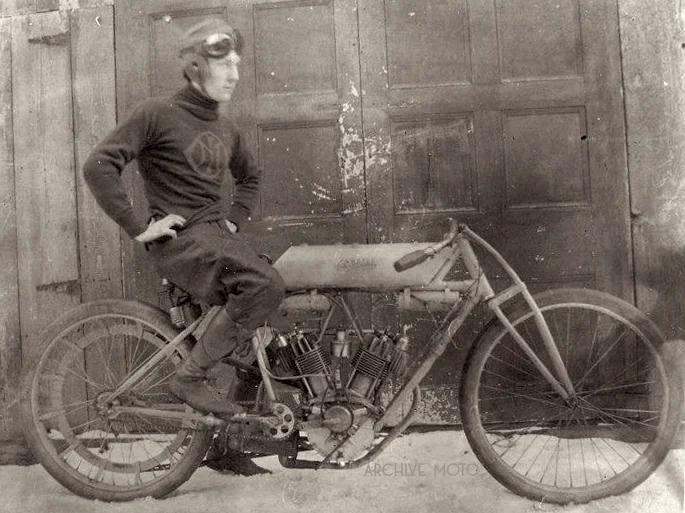Today’s post takes a look into the process, or the madness, however you would describe it, an attempt in any case to identify an intriguing old photo based on very little information. An Italian collector shared this image a few weeks ago and it immediately drew me in. It drew me in not only because of the very stout and capable Curtiss racer, but because the rider looked so familiar. The information that follows has not been confirmed and could turn out to be the result of my over active imagination, the confirmation bias of an odd niche, however it does allow us to explore a character that we may have never known much about.
The nose and the eyes, they are what jump out with an eerie familiarity, but after tracking down a few potential candidates, no connection to Curtiss could be found. The machine, which was made by American motorcycle and aviation pioneer Glenn Curtiss dates to 1909 or 1910, a twin cylinder that shares a heritage with the very first American v-twin motorcycle, introduced by Curtiss back in 1902. This 6HP, belt-driven twin was configured for speed with its rigid front end, drop bars, removed fenders, and smaller tank. Since their debut at the turn of the 20th century these powerful yet reliable Curtiss twins were responsible for countless endurance run wins, speed records, and podium finishes.
Back to the rider, and again the long sturdy nose and piercing eyes remind me of someone, an Ohioan of Welsh decent who became one of the great motorcycle racers America has ever known, Mr. Maldwyn Jones. Maldwyn began racing in 1909 and developed a long lasting loyalty to the brand of his home state, Merkel motorcycles. As Merkel began to lose its foothold in the American motorcycle industry towards WWI, Maldwyn moved on to become a founding and staple member of the Harley-Davidson factory team, a legendary group which would become known as the Wrecking Crew. An innovator, trailblazer, and in his later years a invaluable source of our history, Maldwyn’s legacy is synonymous with early American motorcycle culture. However, what many enthusiast do not realize is that Maldwyn wasn’t the only Jones piloting motorcycles to victory around 1910, his older brother Vernon was also no stranger to the podium. Though the Jones boys were 6 years apart in age, the family’s Welsh genes ran strong and the two shared many features, including their piercing eyes and roman noses.
Vernon too was born and raised in Lebanon, OH and went on to study art at the Cincinnati Art Academy. It is not yet known if Vernon began racing before Maldwyn, or if he was riding before 1909, though it is no stretch of the imagination to understand that the interests of an older brother are soon adopted by the younger. Whatever the case may be, it is known that Vernon, an accomplished artist and sculptor by that time, was hired to design the graphics and layout of the 1909 Curtiss catalogue, as well as work on the companies lettering and logo which would wind up on the tanks of some production models. A rare photograph of Vernon onboard a Curtiss twin in 1909 appears in Stephen Wright’s The American Motorcycle and offers an intriguing comparison to this photo in question. This then may very well be another image of the iconic Maldwyn Jones’ older brother Vernon, sitting onboard a Curtiss racer while he worked for the company, the very same year that his younger brother first threw his leg over a Marsh single and won his first race.
Vernon continued working as an artist and was commissioned in 1912 to prepare a number of sculptures and displays for the Panama-Pacific International Exposition in San Francisco.It was while living in San Francisco on June 22 1914, that Vernon’s enthusiasm for motorcycling would come to an end. While riding his motorcycle through the Golden City’s streets Vernon struck a streetcar while attempting to pass another, succumbing from his injuries by the week’s end. At the time Maldwyn had not yet grown into the racing sensation that his is known for today, though he was well on his way, and as such the local papers from their hometown referred to Vernon as Lebanon’s “most promising young man.” In a tragic case of irony it was reported that Maldwyn, an increasingly popular racer received a letter from Vernon a few days after his brother’s death which Vernon had penned just before his tragic accident urging his younger brother “to be careful in his racing,” cautioning him against the dangers of being too cavalier on the increasingly capable machines.
Though Maldwyn’s legacy is cemented in American motorcycle culture, Vernon’s lives on in the number of sculptures and artworks that remain in museum collections throughout the country. His role in motorcycling history remains unsettled, but may prove to be quite significant as the older brother who lit the way for an icon. Whether or not this is indeed Vernon H. Jones is hard to claim with any certainty, though the little evidence available would suggest that it is, but digging a bit deeper into the live’s of the Jones’ was worth the conjecture.

